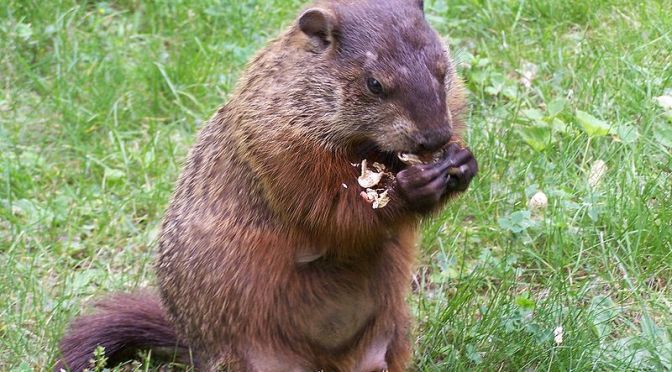By Barbara Walvoord
First published in Lathrop Lamp Post for Jan. 19-25, 2019
Down below the frost line at Lathrop are lots of woodchucks (also called ground hogs), tucked into their burrows, sound asleep. There are more woodchucks around now than in colonial times, because old farms are turning into the “edge” habitat woodchucks like best, where young forest, shrubby old fields, and mowed areas like lawns and trails all intertwine.
Woodchucks are true hibernators. They went to bed in October and won’t emerge until February or March (except, of course, for a look around on Ground Hog Day, February 2).
A sleeping woodchuck did a lot of preparation for the long hibernation. It packed on the pounds in summer, which is hard to do when you only eat vegetables, so each day it had to stuff in up to a third of its weight in grasses, leaves, berries, dandelions, tree bark, clover, nuts, ferns, your newly planted flowers, and your garden beans, peas, and carrots. Woodchucks have been known to climb trees to get apples and pears, and they can decimate a pumpkin patch by taking a bite out of each pumpkin.
Our woodchuck also had to dig its den, perhaps 60 feet long, with tunnels, chambers for sleeping/hibernating and raising young, a separate toilet chamber, and several emergency exits hidden in thickets or tall grasses. It used its long, sharp claws and strong, short legs to push out the dirt—up to 700 pounds of dirt for each of several dens scattered around its territory. Digging under a garden fence is a piece of cake.
Woodchucks are such prolific den diggers that most foxes, skunks, rabbits, opossums, and raccoons just take over old woodchuck dens. Or the old woodchuck hole under your garden fence.
A hormone helps our woodchuck settle down into hibernation. Its breathing rate drops from 80-100 beats per minute way down to 4-5 beats. Its body temperature drops from 98 degrees F. to as low as 38 degrees. Its body fat supplied its reduced need for nutrition. Scientists are exploring how to use the hormone, and the reduced need for oxygen, as a way to reduce damage in humans from stroke or heart attack.
Once our woodchuck emerges from hibernation in early spring, it’s time to rev up fast and get to work! (This quality, too, might be useful to humans). Find huge amounts of food, defend your territory, find a mate, give birth, and nurture the little ones so come fall they can be nice and fat, dig their own burrows, and add to the population of happy woodchucks at Lathrop.

